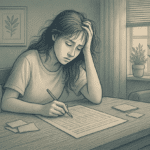Daily Anxiety Journal Template: How to Track Triggers, Emotions, and Patterns

Anxiety can feel overwhelming and unpredictable, but it doesn’t have to control your life. There is a simple and effective tool to help you understand and manage your worries and concerns, and it only takes a few minutes a day. This tool is mental health journaling for anxiety.
Having a daily anxiety journal template can bring you the structure and support you need to track your emotions, recognize patterns, and understand your triggers. Whether you’re new to journaling or want to enhance your ability, this guide demonstrates how to use an anxiety journal for emotional regulation, self-awareness, and long-term progress tracking.
If your anxiety feels like it’s impacting your daily life and ability to function, professional support and guidance is the best route to recovery. However, mental health journaling for anxiety is a good place to start.
On this page, you’ll discover:
- The benefits of daily anxiety journaling
- Template examples
- How to track triggers and progress
- Prompts and tips to get you started
- Where to find mental health support

Why Journaling Helps With Anxiety
If you struggle with anxiety, know that you’re far from alone. Nearly one in five adults in the U.S. has an anxiety condition.1 Yet, even though you’re not alone in your challenges, knowing what to do about them can be confusing. If you’re seeking clarity, journaling could be a great addition to your mental well-being tool-kit.
Generally speaking, journaling is the process of writing about your thoughts and feelings in a notebook. The good news is that journaling for anxiety relief works, and there’s evidence to prove it.2 Studies have found that journaling reduces symptoms of anxiety, mental distress, and can improve your focus.3-7
The reason journaling works is that getting your thoughts and feelings out of your head and onto a piece of paper can feel really cathartic. It helps you to get a sense of distance from your worries. In fact, seeing your thoughts on paper sometimes allows you to see them for what they are: thoughts, not facts.
Some of the main benefits of journaling are:2
- Reducing anxiety, stress, and distress
- Bringing awareness of thoughts and feelings
- Regulating emotions
- Improving well-being
- Recognizing anxiety triggers
- Challenging unhelpful thoughts
- Prioritizing problems
- Releasing distress
With so many benefits to keeping an anxiety management journal, you might be wondering how to get started. What should you write? How much do you need to write? Is there a “right” way to do it? To help answer such questions, we’re going to look at a template for anxiety journaling. This way, you can make sure you get the most out of your journaling practice.
Daily Anxiety Journal Template
Using a template can help when you first begin journaling for anxiety. It gives you a structure to work with, so that you can record specific and relevant information for reflecting and making changes. You’re also more likely to write in your journal consistently if it is easy and quick to do. A template also allows you to track your progress over time.
Just so you know, journaling doesn’t mean you have to write in a notebook – although it can be quite satisfying to do so. You could also keep your journal on your phone in a notes app, or if you like spreadsheets, you could design one to keep track of important details. If you use spreadsheets, you could even create graphs to show your progress.
But what should an anxiety trigger tracking template look like? If you want to use your journal to track symptoms of anxiety and progress, we suggest including the following:
- Date/time: When did you start to feel anxious?
- Trigger: What was happening when the anxiety started?
- Emotion: Name the emotion, for example, is it anxiety, frustration, worry, and so on?
- Physical sensations: Did you feel any sensations, like nausea or pain?
- Thoughts: What thoughts/worries were you having?
- Intensity: On a scale of 0-10, how strongly did you feel?
- Coping strategies: What did you do to try to ease the anxiety?
- Did they help?: Did your strategy help you feel calmer?
- What could I try next time?: Reflect and see what you could do differently next time
Having a journal with information about each event or situation can give you insight into how anxiety affects you, what triggers it, and what works well for relieving your symptoms.
Tips for Journaling Daily
Now that you have a rough journaling structure, let’s get down to the details: emotional tracking for anxiety recovery. How do you put this journaling practice into action?
First, decide how often to journal: Would you prefer to write down all of your triggers and events at the end of the day in one go? Or would you find it easier to write about the anxiety as soon as it happens? There’s no right or wrong way to do this. It comes down to personal preference. If you want to write about each instance of anxiety, you may want to have your journal nearby during the day. If you plan to do a “mind dump” at the end of the day, you could place it on your bedside unit.
Second, follow your template: Use your template to structure your writing. Repeating the same structure makes it easier to write each time. Plus, when you’re in the middle of an anxiety attack or a spiral, you’ll learn which details to remember for your entry afterward. The more you journal, the more natural and automatic it becomes.
Third, set reminders: If you tend to get caught up in things and forget to carry out other tasks, try setting a reminder or alarm. When it goes off, remember if you had any anxiety that you wanted to write about, and then reach for your journal to get writing. Aim to set at least one reminder each day to start with, so that you get your daily journal entry in.
Fourth, be patient: Writing in a journal is a process. Tracking anxiety triggers over days or weeks allows you to deepen your understanding. You’ll start to see if there are patterns in what triggers your anxiety and how you react.
Anxiety Journaling Prompts
It can be tough to understand how to get started with using an anxiety journal for self-awareness and personal exploration. However, prompts can be really useful for helping you think and reflect.
For example, you could ask yourself…
- What made me feel anxious today?
- How did my body react?
- What thoughts kept repeating themselves?
- Did anything help me feel calm?
- What have I learned about myself today?
- Is there anything I can do differently tomorrow?
Remember: there’s no “right way” for using journaling to cope with anxiety. But having a template or prompts can make writing easier to begin, and if something isn’t working for you, you can change your technique. It’s all about discovering what works best for you.
Common Mistakes to Avoid in Anxiety Journaling
We’ve mentioned that there’s no “right” or “wrong” way to journal. And while that’s true, several factors can make journaling to reduce anxiety less useful. For instance, some common mistakes people make are:
Focusing on the Negative Without Reflection
If you use your journal to get thoughts out of your head, that’s absolutely fine. However, don’t leave it there and never read what you wrote. You can return to your journal entries when you feel more balanced, and see what comes to mind re-reading your thoughts. Maybe you’ll notice a pattern, the same worries coming up each time, or a point at which you spiral. But you won’t make those connections unless you reflect on what you’ve written.
Journaling Inconsistently
Journaling is a process. Unfortunately, this means it isn’t a one-and-done deal. To be able to track triggers or notice patterns, you need to have notes to look back on. And you can’t look back and compare how you’re doing if you haven’t written regularly. This is why setting reminders can help you get the most out of your journaling journey.
Avoiding being honest
This journal is for you, and you don’t have to show it to anyone else unless you want to. You’ll get the most out of it if you are totally honest about how you feel and what works for you (or doesn’t). There’s no place for people-pleasing or perfection in journals – just the raw, honest truth.
Long-Term Benefits and Progress Tracking
Earlier, we talked about the benefits of journaling for your mental health. Now, let’s take a closer look at how using a daily anxiety journal can help you in a very practical sense. The long-term benefits of journaling for anxiety include the following.
Progress Tracking
Journaling allows you to see in black-and-white whether your biggest anxiety spike this week is lower than previous weeks. Progress isn’t linear; there will be ups and downs, but seeing a general reduction in your anxiety over days or weeks can spur you on to keep taking action.
Pattern Recognition
You may notice over time that you feel more anxious at a certain time of the day, or before specific events. Or, that you feel much calmer at other times. Begin investigating why you feel more or less anxious, and what may contribute to it. Are there specific triggers?
Building Coping Strategies
By experimenting with different coping strategies and recording how you feel afterward, you can craft your own personalized mental health toolkit. For instance, you can fill your toolbox with grounding techniques and breathwork exercises that work well for you. And you’ll know they work because you’ve got the evidence in your journal to prove it.
Therapy Aid
You can use your journal for therapy sessions. For example, you could look through it with your therapist and notice patterns together that you may have missed on your own. They can help you explore the connections between your thoughts, feelings, and behaviors through techniques such as cognitive behavioral therapy (CBT). As a result, you can learn how to challenge any unhelpful thoughts or behaviors – rewiring your brain to be less anxious.
Finding Professional Anxiety Support
Using a daily anxiety journal for mental health gives you the space and time to reflect on your anxiety from a place of compassion and clarity, rather than fear. A journal can become your personal progress guide on your journey to mental wellness.
If you have an anxiety disorder and want some extra help or advice, talk to us at Mission Connection. We’re experts in treating mental health conditions, using the latest evidence-based treatments to bring you long-lasting relief. We see beyond your symptoms to the unique person you are – creating individualized treatment plans that are geared toward achieving your goals for mental well-being.
Reach out to us at Mission Connection today, and let’s take the first step on your road to long-lasting change and recovery, together.

References
- National Alliance on Mental Illness. (2025, January 3). Anxiety Disorders https://www.nami.org/about-mental-illness/mental-health-conditions/anxiety-disorders/
- Tee-Melegrito, R. A. (2022, February 25). How to journal for anxiety. https://www.medicalnewstoday.com/articles/how-to-journal-for-anxiety
- Smyth, J. M., Johnson, J. A., Auer, B. J., Lehman, E., Talamo, G., & Sciamanna, C. N. (2018). Online Positive Affect Journaling in the Improvement of Mental Distress and Well-Being in General medical patients with Elevated Anxiety Symptoms: a preliminary randomized controlled trial. JMIR Mental Health, 5(4), e11290. https://doi.org/10.2196/11290
- Tan, T. T., Tan, M. P., Lam, C. L., Loh, E. C., Capelle, D. P., Zainuddin, S. I., Ang, B. T., Lim, M. A., Lai, N. Z., Tung, Y. Z., Yee, H. A., Ng, C. G., Ho, G. F., See, M. H., Teh, M. S., Lai, L. L., Singh, R. K. P., Chai, C. S., Ng, D. L. C., & Tan, S. B. (2021). Mindful gratitude journaling: psychological distress, quality of life and suffering in advanced cancer: a randomised controlled trial. BMJ Supportive & Palliative Care, 13(e2), e389–e396. https://doi.org/10.1136/bmjspcare-2021-003068
- Harvard Health. (2017, October 13). Write your anxieties away. https://www.health.harvard.edu/blog/write-your-anxieties-away-2017101312551
- Wang, J. (2021). Informative Journaling Application (Unwind) for Ambient Awareness on Mood in Young Adults to Reduce Anxiety and Depression: A randomized, placebo-controlled trial. Dartmouth Digital Commons. https://digitalcommons.dartmouth.edu/senior_theses/212/
- Lieberman, M. D., Eisenberger, N. I., Crockett, M. J., Tom, S. M., Pfeifer, J. H., & Way, B. M. (2007). Putting feelings into words. Psychological Science, 18(5), 421–428. https://doi.org/10.1111/j.1467-9280.2007.01916.x






